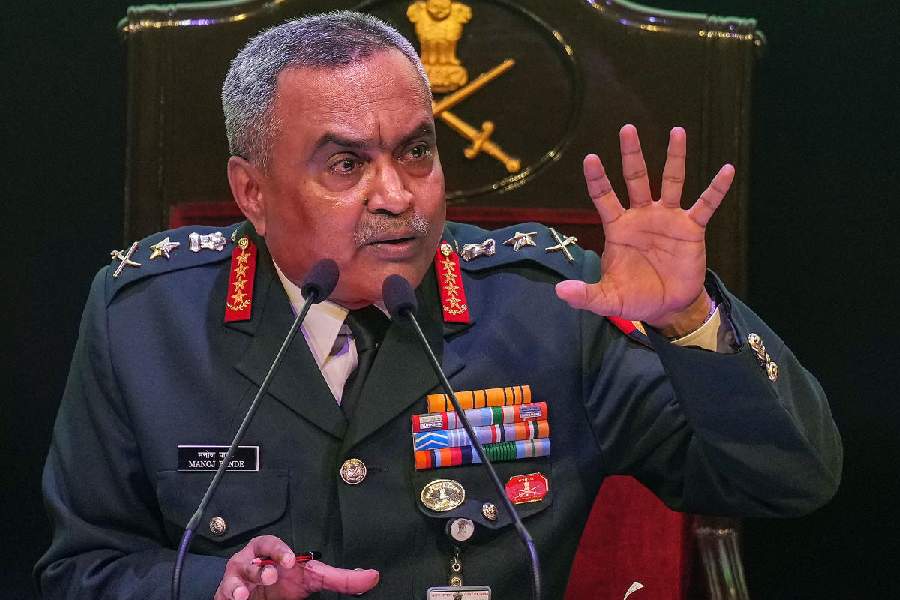Army chief General Manoj Pande on Thursday said India’s immediate aim was to continue holding talks with the Chinese army to ensure restoration of the pre-April 2020 status quo in eastern Ladakh and added the situation along the Line of Actual Control (LAC) was “stable” but “sensitive”.
The reference to the need for restoration of pre-April 2020 status quo appears to contradict Prime Minister Narendra Modi’s claim that nobody had intruded or was occupying Indian territory — “Na wahan koi ghusa hai, na koi ghus aaya hai, na hi ghusa hua hai.”
“Currently, our attempt is to continue the talks with the Chinese army to go back to the pre-April 2020 status quo. Our first aim is to achieve that,” the army chief said while responding to a specific question whether the ground situation in Ladakh was a “new normal”.
The government has denied that India has lost an inch of territory to China.
Four days after the June 15 clash in 2020 in which 20 Indian soldiers were killed, Modi had come out with his “no-intrusion” statement, allowing Beijing to deny any border transgressions and claim ownership of all the territory it held in the region.
Speaking to The Telegraph, a former lieutenant general said the army chief’s statement itself “exposes the government’s no-intrusion claim”.
“If there is no intrusion then why is there a need for restoration of status quo and disengagement along the China frontier?”
He, however, welcomed General Pande’s statement. “Veterans have long been demanding that India must ask China to restore status quo ante and withdraw from the multiple areas that it had transgressed upon in May 2020.”
Addressing a media conference ahead of Army Day, General Pande on Thursday also underlined that Indian troops were maintaining a “high state” of preparedness to deal with any challenges along the LAC and said both India and China continue to hold talks at military and diplomatic levels to find a resolution to the remaining issues.
“Our operational preparedness continues to be at a high level and the Indian Army is maintaining adequate reserves to confront any security challenge in the region. Our deployment is both robust and balanced,” he said.
So far there have been 20 rounds of talks between the Indian and Chinese corps commanders to try and resolve the border standoff. Overall, the Chinese army is estimated to have taken over close to 1,000sqkm of India-claimed territory in Ladakh.
The talks have since then achieved “partial” disengagement from the Galwan Valley, Pangong Lake, Hot Springs and Gogra through the creation of “buffer zones” (a no-man’s land) with the Chinese and Indian armies stepping back by an agreed and equal distance each. This has left the Chinese still within India-claimed lines, while the Indians have retreated within their own territory, fuelling the “ceding more territory” allegations.
The Chinese are refusing to create buffer zones at the Depsang Valley in northeastern Ladakh and at Demchok in southeastern Ladakh, both of which are strategically very important for India.
Last year, a research paper submitted by an IPS officer during the police security conference which was attended by the Prime Minister had flagged how India had lost access to 26 out of 65 patrolling points (PPs) in eastern Ladakh following Chinese incursion. These 26 PPs were patrolled by Indian security forces before the Chinese transgression in April-May 2020.
The LAC between India and China are not demarcated and both sides have a perception of each other’s claim line based on decades of patrolling patterns.
Military veterans have flagged what they see as India's ceding of more territory to the Chinese through the establishment of non-militarised “buffer zones” at multiple transgression points and have cited the long stalemate, and the recent post-talk silence on a return to status quo ante, to suggest that India is capitulating to a Chinese plan to establish a new status quo along the LAC.
“The army chief’s emphasis on restoration of the status quo is a welcome step. The government now must walk the talk,” said another veteran.
Agnipath scheme
General Pande said the integration of Agniveers into the army was moving forward well.
He, however, declined to comment on his predecessor Manoj Mukund Naravane's disclosure in his memoir that the Agnipath scheme launched by the Modi government had surprised the army while it was a "bolt out of the blue" for the navy and the air force.
“We in the army were taken by surprise by this turn of events, but for the navy and air force it came like a bolt from the blue,” General Naravane was earlier quoted by PTI as having written in his yet-to-be-published memoir Four Stars of Destiny.
Sources said the army was reviewing Naravane’s memoir, which also discloses details of a conversation he had with defence minister Rajnath Singh on the ongoing border standoff with China in eastern Ladakh and has some details of the Galwan clash in which 20 Indian soldiers were killed.











